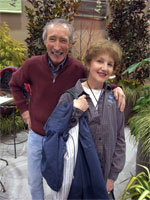Ten Easy Tips
Getting Started
Shady Areas
Containers
Unusual Herbs
Ground Covers
Mint
Herb Warnings
Harvest Time
Extras
Healthy Gardening
Juli Jance
Contact Julie
|
Thyme For Sage Advice is now on a wordpress blog where you can leave questions and comments about these tips. Go to the blog now.
Ten Terrific Tips For Great Herb Growing

With Cisco at the 2009 Flower and Garden show in Seattle (enlarge)
These tips are for those who want to share in the experience of growing herbs in their own gardens successfully. J.G. Jance has been growing herbs for many years and has accumulated a wealth of knowledge to share with those who might just be getting started, or for those who already grow their own herbs but have difficulties in some areas. Feel free to contact Julie with herb questions or issues related to other horiculture and gardening areas.
- Basil
Disregard the basil set out in March or April. This is for anxious gardeners to plant immediately into their not quite frost-free gardens. Basil is very fond of warmth and enjoys growing in the full sun. Cold weather will not encourage growth. Wait until May or even June if you are planting directly in the garden.
- Corsican Mint
This is a wonderful, low, compact, exotic scented ground cover. Watch for invasive moss, though, it will wipe out your mint. Be very observant when you buy Corsican mint because the moss may already be growing in the small plants. Moss seems to have a real affinity for this ground cover and once it gets in, it spreads to other parts of your garden.
For more, see Ground Covers and Hedges
- Flavored Vinegars
For the most subtle, true flavor, use wine vinegar. Recipes will suggest cider and distilled, but for a truly delicious fruit or herb vinegar, use white, red, or champagne vinegar, depending upon your herbs.
For more, see Harvest Tips
- Lavender and Thyme
These herbs are good neighbors in any hot, dry, location. Well-drained soil is a must, but overdoing fertilizer will not produce the highly scented flowers we associate with Lavender, and the distinct scent of Thyme will be lost as well. Less rich soil equals more intense scent. Remember that herbs dried are more intense than fresh herbs.
- Mint
Anyone can grow Mint. That is, if it is grown in the right place. Mint does not grow well in hot and dry locations.
Mint is one of those herbs where buying the starter plant is best. There are so many to choose from (try chocolate for a heady scent). Keep a close eye on the Latin name when purchasing mint starters, especially if you are buying peppermint.
For more, see Growing Mint
- Drying Herbs
Drying clean herbs is a good idea, but drying "dry" herbs is required. The best bet is to gently wash the herbs with a hose early in the day before harvesting. Pick them the next day after all the dew has left the leaves and then dry accordingly.
For more, see Harvesting
- Lemon Grass
Lemon Grass can be grown in the home garden, however, it doesn't make it through most of our winters. If it is grown in a container, lemon grass can be moved indoors during the cold weather. This herb is available in most Asian grocery stores. Purchase a bunch, place it in water (change the water daily), and in no time at all rooted lemon grass will be ready for planting in the garden or in a large container. Lemon Grass likes a bit of shade.
For more, see Container Gardening
- Saffron
Saffron is the most expensive spice in the world, however you can grow it without too much trouble. Start with the standard order from a nursery. If bulbs are mail ordered, the bulbs will arrive in the fall. In a few years, with regular feeding and soil amending, the individual bulb will have exploded into a clump that can be divided. Pretty lavender crocus flowers are a bonus in the fall.
For more, see Unusual Easy Herbs
- Lovage
This is a great old herb that tastes like celery and in a pinch makes a great substitute. It's large, around five feet tall, but easy to grow and doesn't even mind some shade. It's a perennial and will die to the ground in the winter, but in the spring it will return. As a bonus, you may even find swallowtail butterflies getting ready for their winter as they nibble away at it. This is a great and useful herb to grow.
For more, see Unusual Easy Herbs
- Creeper Containment
Cement blocks are good for containing creeping mint, but what about a ground cover that is determined to cover more ground than is desired? Some Sedums, Campanula, and Japanese Lantern plants are very invasive, but one herbal ground cover may be the worst!
For more, see Invasive Herbs
|

